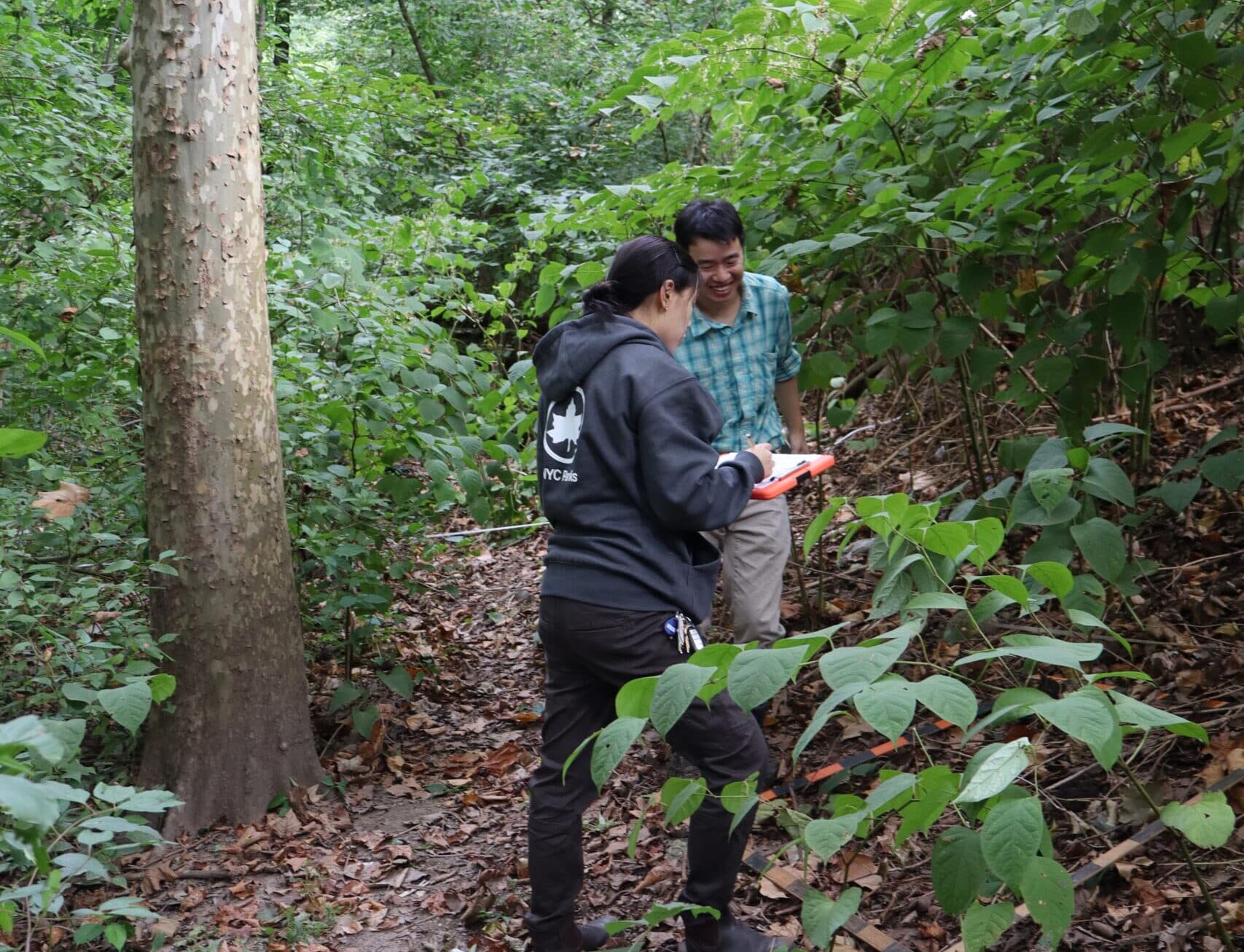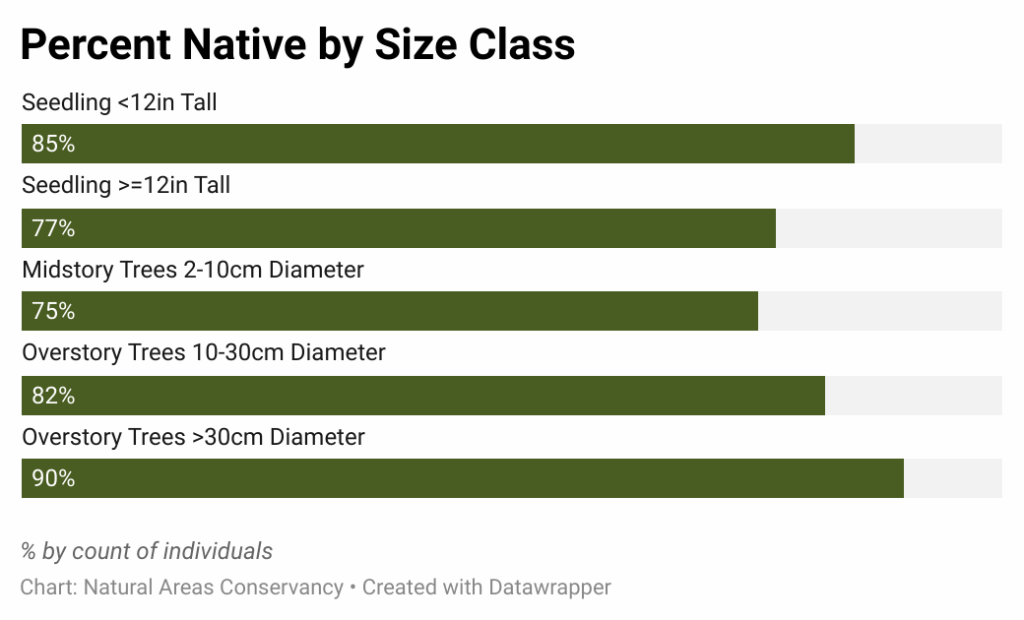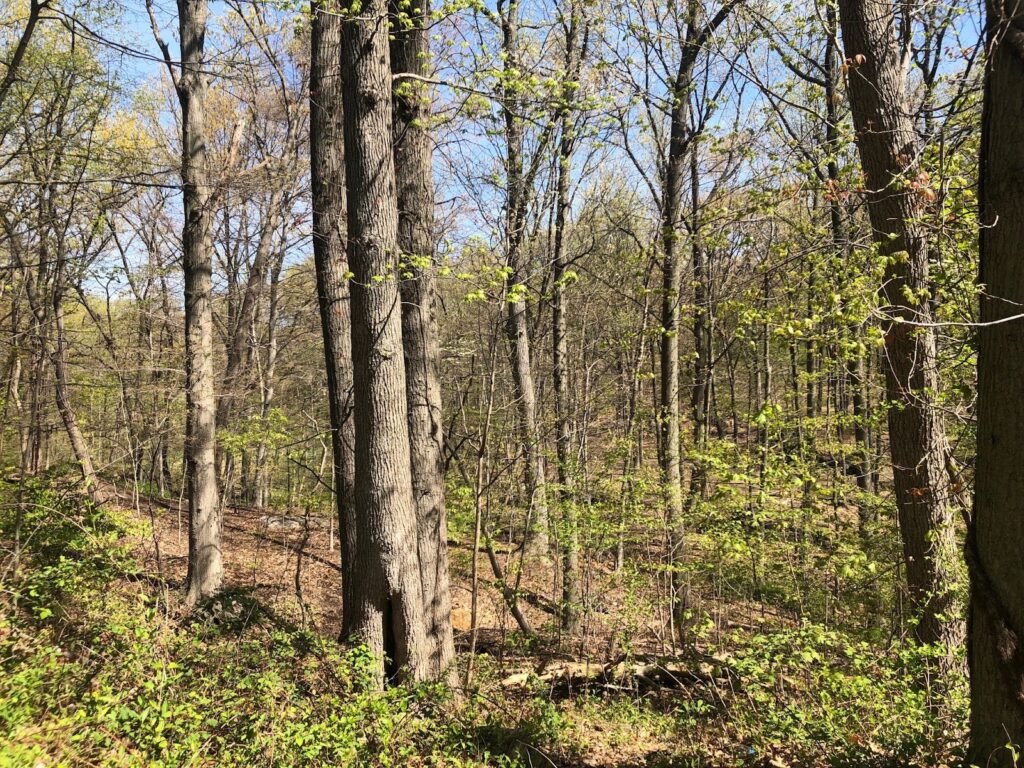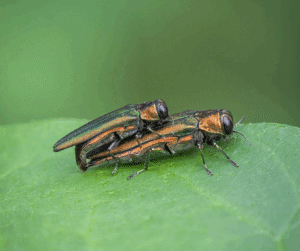NYC’s Forests, 10 Years Later: 4 Early Takeaways from Our Second Forest Assessment
By Natural Areas Conservancy on May 12, 2025

By Natural Areas Conservancy on May 12, 2025

How are NYC forests doing? The results from our second citywide Ecological Assessment (EA 2.0) are in! While analysis is ongoing, initial findings reveal a complex picture. On one hand, our large, native overstory trees are growing; on the other, we see an expanding presence of invasive vines that could limit these gains in the future, as well as some notable losses driven by a little beetle. It’s evident our city’s forested natural areas are under threat—and chronic disinvestment is not helping. For the future health of our forests, these threats must be managed, and we need sufficient funding from the City to ensure intervention and maintenance.
The Natural Areas Conservancy and NYC Parks launched EA 2.0 last summer, collecting data on New York City’s forest, freshwater wetland, and salt marsh habitats— a follow-up to our landmark effort 10 years ago. This decade-spanning assessment allows us to understand the current condition of NYC’s ecosystems, how they are changing over time, and what they need to thrive.
Data collection and analysis for freshwater wetlands and salt marshes are still underway, but we’re excited to share some early insights and synthesis from the forest assessment.
In 2024, we surveyed 317 forest plots—each 10 meters in radius—across all five boroughs. Of the 317 locations, 241 were originally surveyed in 2014 and include individually tagged trees, allowing for direct comparisons over time. The remaining 76 plots were added and tagged in 2024, expanding our monitoring network and laying the groundwork for the future of this program.

NYC’s mature forest canopy—the overstory (trees >10cm in diameter)—is largely intact and remains predominantly native. Over the last decade, our native overstory basal area (the space trees occupy) has grown by 12%, with 90% of the largest overstory trees (those >30cm in diameter) being native. However, we’re seeing lower native proportion among younger tree age classes, where smaller overstory trees (10-30cm in diameter) are 82% native, and saplings only 75%.
Additionally, 291 of the locations we visited are typical broadleaf deciduous forests found in our northeast temperate region. These plant communities—distinct collections of species that grow together—when mature, are characterized by large tree species, which should have multiple age/size classes to ensure their ability to persist. We found that while all but one location had overstory trees present and 95% had saplings (trees 2-10cm in diameter), only 35% of locations contained larger, more advanced tree seedlings (>=12 inches tall) that are more likely to survive than smaller seedlings.
Understanding what this means for the future of our forest, and what might be driving this change still requires more work, but it is clear that if this trajectory of decreasing native younger trees and absent regeneration continues, we could reach a point in our future where native, regenerating forests are declining in NYC.

Healthy mature forests in NYC have well developed structure with native overstory trees, younger smaller diameter trees and shrubs, seedling trees and native herbaceous plants
Invasive vines are spreading rapidly across NYC’s forests. These species are known to smother groundcover, overwhelm saplings, and strangle mature canopy trees. In 2014, invasive vines were found in 82% of our 241 marked plots; by 2024, that number had risen to 91%—a troubling increase in just a decade. Across all 317 sites, the most common species were Asiatic bittersweet and porcelain berry—each present at the majority of plots. On average, invasive vines are now impacting 39% of overstory trees and 34% of saplings and shrubs (collectively, midstory).
This finding is important because invasive vines have a well documented history of expanding and leading to canopy decline. So even though less than 50% of individual trees are impacted, 100% of trees in the vicinity of these vines are at risk of decline. If left unchecked, these vines will damage our forest systems and result in losses to places that offer respite for nature lovers, provide carbon storage and sequestration benefits, and serve as habitat for NYC’s wildlife.

In North America, the lack of resistance and effective controls for the emerald ash borer have led to widespread ash mortality — and unfortunately the ash trees in NYC are not being spared. Our ash trees experienced significant losses between 2014 and 2024 across the 241 plots we resurveyed. The period of this decline aligns with the 2017 arrival of the emerald ash borer in NYC. Of the 98 overstory ash trees tagged in 2014, 76 died by 2024, and only 15 new overstory ash trees grew in their place, resulting in a net loss of 61 trees in our plots. Additional findings show that most of the remaining trees declined in health, which may indicate infestation.
Because ash trees themselves are unlikely to recover, the wetland plant communities they supported will require proactive restoration, including the planting of appropriate native tree species to reduce climate vulnerability of these systems.
The average abundance of native vegetation covering the forest floor declined by 31%, with 60% of resurveyed locations showing a drop since 2014. Interestingly, the abundance of invasive groundcover remained largely unchanged over the same period. This decline is concerning because groundcover plays a vital ecological role—it helps prevent erosion, increases stormwater capture, provides wildlife habitat, and includes young tree seedlings that support future canopy regeneration. While we’re still exploring the causes of this loss, two potential contributors are the deer that feed on plants in many of NYC’s forested natural areas, and the prolonged drought conditions during summer 2024.
Stay tuned for more results from the EA 2.0!
In 2024, the City cut funding for NYC Parks natural areas management staff. Recent federal rollbacks delivered a compounding blow and have stripped away funding streams that would have helped offset underfunding. We are at a critical moment for NYC natural areas—and we need your help! Firstly, you can help us advocate for sustained funding in Parks and natural areas, which will ensure threats to our forests can be addressed. We also welcome volunteers to join us on NYC trails to help make green spaces more accessible to New Yorkers. Lastly, we welcome donations of any size, which will go directly to our mission to preserve and champion natural areas.